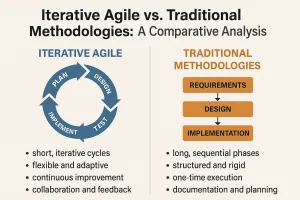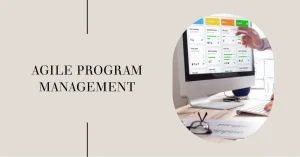Introduction
Understanding the distinctions between the program life cycle and the project life cycle is crucial for new project managers and students. Both concepts play a vital role in the successful execution of initiatives, yet they serve different purposes and operate at different levels within an organization.
Defining Program Life Cycle and Project Life Cycle
- Program Life Cycle: The program life cycle refers to the structured phases that a program undergoes from initiation to closure. A program is a collection of related projects managed in a coordinated manner to obtain benefits and control not available from managing them individually. The program life cycle typically includes phases such as initiation, planning, execution, monitoring and controlling, and closure. Each phase is designed to ensure that the program aligns with strategic objectives and delivers value to the organization.
- Project Life Cycle: In contrast, the project life cycle encompasses the stages a single project goes through from start to finish. This cycle usually consists of four or five phases: initiation, planning, execution, monitoring and controlling, and closure. Each phase focuses on specific deliverables and outcomes, ensuring that the project meets its objectives within the defined constraints of time, budget, and resources.
Significance in Project Management
Understanding the differences between the program and project life cycles is essential for several reasons:
- Resource Allocation: Programs often require a broader allocation of resources and strategic oversight, while projects focus on specific deliverables and outcomes. Recognizing these distinctions helps project managers allocate resources effectively and prioritize tasks.
- Risk Management: Programs typically involve higher levels of complexity and risk due to the interdependencies between projects. Understanding the program life cycle allows project managers to identify and mitigate risks that may impact multiple projects within the program.
- Strategic Alignment: Programs are aligned with organizational strategy, ensuring that the projects within them contribute to broader business goals. This alignment is crucial for maximizing the value delivered to stakeholders.
Purpose of the Blog Post
This blog post aims to clarify the distinctions and overlaps between the program life cycle and the project life cycle. By exploring these concepts, new project managers and students will gain a deeper understanding of how to navigate the complexities of project management. This knowledge will empower them to manage projects and programs more effectively, ultimately leading to successful outcomes and enhanced organizational performance.
Understanding Project Management
Project management is a structured approach to planning, executing, and overseeing projects to achieve specific goals within defined constraints such as time, budget, and resources. It involves applying knowledge, skills, tools, and techniques to project activities to meet project requirements. Effective project management ensures that projects are completed successfully, delivering the intended outcomes and benefits.
Key Phases of the Project Life Cycle
The project life cycle consists of five key phases, each with distinct objectives and deliverables:
- Initiation
- Objective: To define the project at a high level and secure authorization to proceed.
- Deliverables: A project charter or project initiation document (PID) that outlines the project’s purpose, objectives, stakeholders, and high-level requirements. This phase also includes identifying key stakeholders and conducting a feasibility study to assess the project’s viability.
- Planning
- Objective: To establish a detailed roadmap for how the project will be executed, monitored, and closed.
- Deliverables: A comprehensive project management plan that includes the scope statement, work breakdown structure (WBS), schedule, budget, risk management plan, and communication plan. This phase is crucial for setting clear expectations and aligning stakeholders on project goals.
- Execution
- Objective: To implement the project plan by coordinating people and resources, as well as managing stakeholder engagement.
- Deliverables: Completed project deliverables, which may include products, services, or results as defined in the project scope. This phase involves executing tasks, managing teams, and ensuring quality standards are met.
- Monitoring & Controlling
- Objective: To track, review, and regulate the progress and performance of the project and identify any areas where changes to the plan are required.
- Deliverables: Performance reports, change requests, and updated project documentation. This phase ensures that the project remains on track and within budget, allowing for adjustments as necessary to address any issues or risks that arise.
- Closing
- Objective: To finalize all project activities, formally close the project, and evaluate its success.
- Deliverables: A project closure report, which includes a summary of project performance, lessons learned, and documentation of the final deliverables. This phase also involves releasing project resources and conducting a post-project evaluation to assess what went well and what could be improved in future projects.
Understanding the project life cycle is essential for new project managers and students as it provides a framework for managing projects effectively. Each phase plays a critical role in ensuring that projects are completed successfully, meeting the defined objectives and delivering value to stakeholders. By grasping these foundational principles, aspiring project managers can better navigate the complexities of project management and contribute to their teams’ success.
Understanding Program Management
Program management is a crucial aspect of project management that focuses on managing multiple related projects in a coordinated manner to achieve strategic objectives. It encompasses a broader scope than project management, which typically deals with individual projects. Here’s a detailed look at what program management entails and how it differs from project management.
Definition of Program Management
Program management is defined as the process of managing several related projects simultaneously to achieve specific business goals and benefits. Unlike project management, which is concerned with the execution of a single project, program management involves overseeing a collection of projects that are interrelated and aligned with a common strategic objective. This holistic approach allows organizations to optimize resources, manage risks more effectively, and deliver greater value.
The Concept of a Program and Its Relationship to Projects
A program is essentially a group of related projects that are managed in a coordinated way to obtain benefits and control not available from managing them individually. The relationship between programs and projects can be summarized as follows:
- Interdependency: Projects within a program are often interdependent, meaning the outcome of one project can affect the others. This interrelationship necessitates a coordinated approach to management.
- Strategic Alignment: Programs are designed to achieve broader organizational goals, while projects focus on specific deliverables. The success of a program is measured by its ability to deliver strategic benefits, which may not be achievable through individual projects alone.
Key Phases of the Program Life Cycle
The program life cycle consists of several key phases, each with distinct objectives and deliverables:
- Initiation:
- Objectives: Define the program’s purpose, scope, and alignment with organizational strategy. Identify stakeholders and establish governance structures.
- Deliverables: Program charter, stakeholder analysis, and initial risk assessment.
- Planning:
- Objectives: Develop a comprehensive program plan that outlines how the program will be executed, monitored, and controlled. This includes resource allocation, scheduling, and risk management strategies.
- Deliverables: Program management plan, detailed project plans for each project within the program, and a benefits realization plan.
- Execution:
- Objectives: Implement the program plan by coordinating the execution of individual projects. Ensure that resources are effectively utilized and that projects are aligned with the program’s goals.
- Deliverables: Progress reports, performance metrics, and stakeholder communication updates.
- Closure:
- Objectives: Conclude the program by ensuring that all projects are completed, benefits are realized, and lessons learned are documented. This phase also involves transitioning deliverables to operational teams.
- Deliverables: Program closure report, final performance evaluation, and a benefits realization assessment.
Understanding program management is essential for new project managers and students as it provides a framework for managing complex initiatives that require coordination across multiple projects. By recognizing the distinctions and overlaps between program and project management, individuals can better navigate their roles and contribute to the successful delivery of organizational objectives.
Key Differences Between Program Life Cycle and Project Life Cycle
Understanding the distinctions between the program life cycle and the project life cycle is crucial for new project managers and students entering the field of project management. While both are essential components of effective management, they serve different purposes and operate under different frameworks. Here are the key differences:
- Scope:
- Project Life Cycle: A project is defined by its specific deliverables and outcomes. It has a clear scope that outlines what needs to be accomplished within a set timeframe. Projects are often focused on producing a unique product, service, or result, which means that the scope is narrow and well-defined.
- Program Life Cycle: In contrast, a program encompasses a broader scope that aligns with strategic objectives of an organization. Programs are designed to achieve long-term goals and may include multiple related projects that contribute to a larger vision. This means that the scope of a program is more expansive and can evolve over time as organizational needs change.
- Duration:
- Project Life Cycle: Projects are inherently temporary endeavors with a defined beginning and end. They are initiated to achieve specific objectives and are completed once those objectives are met. The duration of a project can vary significantly, but it is always finite.
- Program Life Cycle: Programs, on the other hand, may be ongoing and do not have a fixed end date. They are designed to manage and coordinate multiple projects over an extended period, allowing for continuous improvement and adaptation to changing circumstances. This ongoing nature means that programs can evolve as new projects are added or existing projects are modified.
- Resource Management:
- Project Life Cycle: Resource management in projects is typically focused on the specific resources required to complete the project. This includes budgeting, staffing, and scheduling resources that are dedicated solely to the project at hand. The management of these resources is critical to ensure that the project is completed on time and within budget.
- Program Life Cycle: In programs, resource management is more complex as it involves overseeing resources across multiple projects. This means that program managers must allocate resources strategically to ensure that all projects within the program are adequately supported. Effective resource management at the program level can lead to better utilization of resources and improved overall efficiency.
- Objectives:
- Project Life Cycle: The objectives of a project are primarily tactical, focusing on the immediate goals and deliverables that need to be achieved. These objectives are often specific, measurable, and time-bound, guiding the project team in their efforts to complete the project successfully.
- Program Life Cycle: Conversely, program objectives are strategic in nature. They are aligned with the long-term goals of the organization and focus on delivering value over time. Program objectives may include enhancing organizational capabilities, improving customer satisfaction, or achieving competitive advantages, which require a broader perspective and a longer-term commitment.
Overlaps Between Program and Project Management
Understanding the distinctions and overlaps between program and project management is crucial for new project managers and students. While programs and projects serve different purposes, they share several commonalities that can enhance the effectiveness of management practices. Here are some key areas where program and project management intersect:
Common Processes and Methodologies
- Frameworks and Standards: Both program and project management often utilize established frameworks such as PMBOK (Project Management Body of Knowledge) and PRINCE2 (Projects in Controlled Environments). These methodologies provide structured approaches to planning, executing, and closing projects and programs, ensuring consistency and quality across initiatives.
- Phases of Management: Both life cycles typically include similar phases: initiation, planning, execution, monitoring and controlling, and closing. This alignment allows project managers to apply skills and knowledge from project management to program management, facilitating smoother transitions and integration of efforts.
- Agile Practices: Many organizations adopt Agile methodologies for both projects and programs, emphasizing iterative development, flexibility, and collaboration. This shared approach fosters a culture of continuous improvement and responsiveness to change, benefiting both project and program outcomes.
Importance of Stakeholder Engagement
- Stakeholder Identification and Analysis: In both project and program management, identifying and analyzing stakeholders is vital. Understanding their needs, expectations, and influence helps ensure that both projects and programs align with organizational goals and stakeholder interests.
- Communication Strategies: Effective communication is a cornerstone of both disciplines. Engaging stakeholders through regular updates, feedback loops, and collaborative decision-making processes enhances transparency and fosters trust, which is essential for the success of both projects and programs.
- Conflict Resolution: Both project and program managers must navigate conflicts among stakeholders. Utilizing similar conflict resolution strategies can help maintain relationships and ensure that both projects and programs progress smoothly.
Lessons Learned
- Knowledge Transfer: Lessons learned from individual projects can significantly inform program management. By analyzing what worked well and what didn’t in past projects, program managers can make more informed decisions, mitigate risks, and enhance the overall success of the program.
- Best Practices: Successful practices identified in project management can be scaled and adapted for program management. This includes resource allocation, risk management strategies, and performance measurement techniques that have proven effective in project contexts.
- Continuous Improvement: Both disciplines benefit from a culture of continuous improvement. By documenting and sharing lessons learned, organizations can create a repository of knowledge that enhances future project and program performance.
While program and project management have distinct objectives and scopes, they share significant overlaps in processes, stakeholder engagement, and the application of lessons learned. Recognizing these similarities can empower new project managers and students to leverage their skills across both domains, ultimately leading to more successful outcomes in their management endeavors.
Conclusion
Understanding the distinctions and overlaps between the program life cycle and the project life cycle is crucial for effective management and successful outcomes. Here are the key takeaways:
- Definitions and Distinctions: The project life cycle refers to the series of phases that a project goes through from initiation to closure, focusing on specific deliverables and objectives. In contrast, the program life cycle encompasses a broader scope, managing multiple related projects that align with strategic goals. While projects are temporary endeavors with defined outputs, programs are ongoing and aim to achieve long-term benefits through coordinated management of interrelated projects.
- Importance of Knowledge Application: For new project managers and students, grasping these concepts is essential. By recognizing how programs and projects differ, you can better allocate resources, manage risks, and align your efforts with organizational objectives. This understanding will enhance your ability to navigate complex project environments and contribute to the success of both individual projects and overarching programs.
- Resources for Further Learning: To deepen your knowledge of project and program management, consider exploring the following resources:
- Books: Look for titles such as “The Standard for Program Management” by the Project Management Institute (PMI) and “Project Management: A Systems Approach to Planning, Scheduling, and Controlling” by Harold Kerzner.
- Online Courses: Platforms like Coursera and LinkedIn Learning offer courses on project and program management that can provide valuable insights and practical skills.
- Professional Organizations: Joining organizations like PMI or the International Project Management Association (IPMA) can provide access to a wealth of resources, networking opportunities, and certifications that enhance your professional development.
By integrating the knowledge of both life cycles into your project management practices, you will be better equipped to lead projects effectively and contribute to the strategic success of your organization.
Find out more about Shaun Stoltz https://www.shaunstoltz.com/about/.
This post was written by an AI and reviewed/edited by a human.



